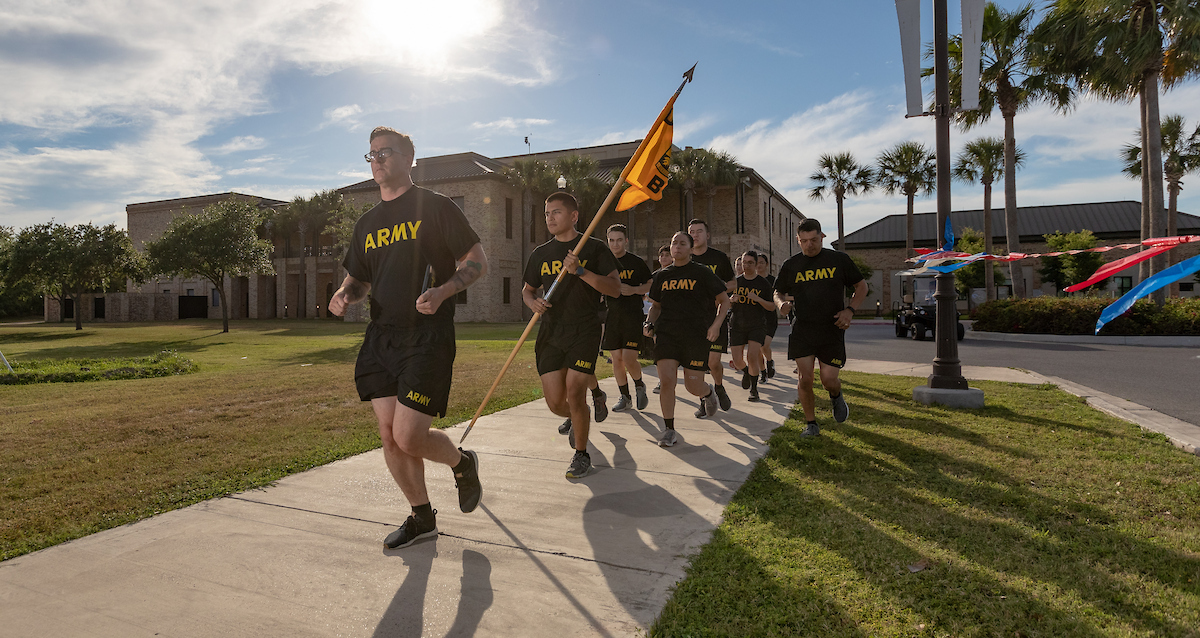Your Role as a Cadet
Participation
To be in the Army ROTC program you must be a full-time student in good standing with the University of Texas Rio Grande Valley. No restriction is placed on your academic major (unless you are a scholarship cadet) other than requiring normal progress toward a degree. You are expected to attend all scheduled ROTC classes and labs as well as your academic curriculum classes. If it becomes impossible to attend a particular class, report this to your instructor prior to the class.
Contracted and enrolled students will participate in all events (classroom, field training, and physical training). Auditing and participating students will only participate in the classroom portion of ROTC. Participation in any of the extracurricular activities and organizations sponsored by ROTC is voluntary.
Conduct
Your conduct, both in and out of uniform, must be praiseworthy and you must exhibit those qualities consistent with the status and position of a commissioned officer. Specifically, you should be neat in appearance, have a neatly groomed haircut, and observe military courtesy. Take pride in your appearance, your uniform, and your conduct. While you are in uniform, you represent the Army and your fellow cadets in the eyes of others. Auditing and participating students do not need to meet Army requirements (e.g. a military haircut).
Sponsorship Program
New students are provided with an upper-class cadet as a sponsor. The sponsor will help the new student pick up their uniforms and equipment; teach them the proper way to wear the uniform, and provide instruction in maintaining the uniform (i.e., placement of patches.) The sponsor will also help the new student locate campus classrooms; and should answer questions about purchasing textbooks, housing, and campus life. The role of the sponsor does not end after initial processing, but continues throughout the term. Your sponsor will be able to answer most of your questions and if they are unable to then the cadre are always available to assist you.
Vaqueros Program Mission
UTRGV ROTC program partners with the university to recruit, educate, retain, develop, and inspire SROTC cadets to become commission officers of character for the Total Army who are adaptive, agile, and critical thinkers; partnering with high schools to conduct JROTC to motivate young adults to become better citizens and leaders in the community.
5th USACC Brigade
Commissions officers who are agile, adaptive, critical thinkers ready to lead in a complex environment; develop an adaptable cadre capable of providing master level leader development and inspirational instruction; and inspire young students in the JROTC citizenship program to become the future leaders of America.
U.S. Army Cadet Command
USACC partners with universities to recruit, educate, develop, and inspire SROTC Cadets in order to commission officers of character for the Total Army; and partners with high schools to conduct JROTC in order to develop citizens of character for a lifetime of commitment and service to our Nation.
The university mascot is the “Vaquero” or the “Cowboy” in Spanish. The University of Texas Rio Grande Valley Army ROTC program began in 1981 as the Pan American University Bronc Battalion. The program commissioned its first lieutenants in 1982. In 1988, the University’s name changed to the University of Texas-Pan American and retained its Bronc mascot.
In 1992, the University of Texas at Brownsville became an extension campus of the UTPA ROTC program. In 2006, the program was recognized as the General Douglas MacArthur Award winner for the Best Battalion in Cadet Command in the Small School Category.
In 2015, the University of Texas-Pan American was renamed the University of Texas Rio Grande Valley, and in 2016 the former campus of the University of Texas at Brownsville became part of UTRGV. The Battalion’s designation was changed to the Vaqueros Battalion and consists of Bronc Company (A) in Edinburg and Scorpion Company (B) in Brownsville.
Symbolism of the ROTC Crest
The shoulder loop insignia contains three main symbols: the chevron, the star, and the school’s colors. The chevron reversed alludes to the letter ‘V’, signifying Vaqueros, the school mascot, as well as the Rio Grande Valley. The solitary star is in tribute to Texas, the Lone Star State, and orange, blue, and green are the school’s colors.
Army ROTC produces 75% of all Army officers. Founded in 1916, ROTC has produced more than one-half million lieutenants for America's Army. It remains the broadest avenue for men and women seeking to serve as officers in the Army. The Army officer is a prestigious professional who serves as a leader in the most respected institution in America.
Your Soldier can enroll in Army ROTC as a college elective for up to two years with no obligation. ROTC gives you a wide range of experiences while you work toward a degree. You'll combine your time in the classroom with hands-on experience. If you choose not to make the Army your career, you will have acquired job skills that are sure to give you a definite advantage over your peers when the time comes to seek civilian employment. Whether you're planning a career in the Army or the corporate world, Army ROTC is a smart elective course to take.
As part of Army ROTC, you'll be in the company of a diverse group of individuals with broad interests who excelled in their chosen areas of interest. They may have been presidents of their student governments, captains of their varsity sports teams, club presidents, or members of the National Honor Society.
Their studies will include: Leadership Development, Military Skills, and Adventure Training. Army ROTC courses teach you how to succeed in a competitive world both in college and beyond.
Many prominent Americans got their start through Army ROTC.
Army ROTC is the best leadership course in America!
Training
Summer Training Opportunities for Contracted Cadets
Northern Warfare training is a three week course taught at the Northern Warfare Training Center in Ft. Greely, Alaska. Students are taught basic mountain climbing and mountaineering skills including rock climbing, mountain walking techniques, basic knots, ice climbing, and route selection. The course culminates in a three day field exercise that takes place on Gulkana Glacier. Students learn the importance of trusting their equipment and build confidence in themselves.
NOTE: very physically demanding.
Activities
Student Involvement
The Bataan Memorial Death March honors a special group of World War II heroes. These brave soldiers were responsible for the defense of the islands of Luzon, and Corregidor, and the harbor defense forts of the Philippines.
The conditions they encountered and the aftermath of the battle were unique. They fought in a malaria-infested region, surviving on half or quarter rations with little or no medical help. They fought with outdated equipment and virtually no air power.
On April 9, 1942, tens of thousands of American and Filipino soldiers were surrendered to Japanese forces. The Americans were Army, Army Air Corps, Navy and Marines. Among those seized were members of the 200th Coast Artillery, New Mexico National Guard.
They were marched for days in the scorching heat through the Philippine jungles. Thousands died. Those who survived faced the hardships of a prisoner of war camp. Others were wounded or killed when unmarked enemy ships transporting prisoners of war to Japan were sunk by U.S. air and naval forces.

